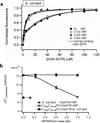Dramatic destabilization of transmembrane helix interactions by features of natural membrane environments
- PMID: 21682279
- PMCID: PMC3140635
- DOI: 10.1021/ja204524c
Dramatic destabilization of transmembrane helix interactions by features of natural membrane environments
Abstract
Membrane proteins have evolved to fold and function in a lipid bilayer, so it is generally assumed that their stability should be optimized in a natural membrane environment. Yet optimal stability is not always in accord with optimization of function, so evolutionary pressure, occurring in a complex membrane environment, may favor marginal stability. Here, we find that the transmembrane helix dimer, glycophorin A (GpATM), is actually much less stable in the heterogeneous environment of a natural membrane than it is in model membranes and even common detergents. The primary destabilizing factors are electrostatic interactions between charged lipids and charged GpATM side chains, and nonspecific competition from other membrane proteins. These effects overwhelm stabilizing contributions from lateral packing pressure and excluded volume. Our work illustrates how evolution can employ membrane composition to modulate protein stability.
Figures







Similar articles
-
Detergent properties influence the stability of the glycophorin A transmembrane helix dimer in lysophosphatidylcholine micelles.Biophys J. 2012 Dec 19;103(12):2455-64. doi: 10.1016/j.bpj.2012.11.004. Epub 2012 Dec 18. Biophys J. 2012. PMID: 23260047 Free PMC article.
-
Lipid-modulated sequence-specific association of glycophorin A in membranes.Biophys J. 2010 Jul 7;99(1):284-92. doi: 10.1016/j.bpj.2010.04.005. Biophys J. 2010. PMID: 20655857 Free PMC article.
-
Molecular dynamics simulations of the dimerization of transmembrane alpha-helices.Acc Chem Res. 2010 Mar 16;43(3):388-96. doi: 10.1021/ar900211k. Acc Chem Res. 2010. PMID: 20017540
-
Ca2+ -ATPase structure in the E1 and E2 conformations: mechanism, helix-helix and helix-lipid interactions.Biochim Biophys Acta. 2002 Oct 11;1565(2):246-66. doi: 10.1016/s0005-2736(02)00573-4. Biochim Biophys Acta. 2002. PMID: 12409199 Review.
-
Membranes Do Not Tell Proteins How To Fold.Biochemistry. 2016 Jan 12;55(1):5-18. doi: 10.1021/acs.biochem.5b01134. Epub 2015 Dec 19. Biochemistry. 2016. PMID: 26649989 Review.
Cited by
-
Identification of destabilizing and stabilizing mutations of Ste2p, a G protein-coupled receptor in Saccharomyces cerevisiae.Biochemistry. 2015 Mar 10;54(9):1787-806. doi: 10.1021/bi501314t. Epub 2015 Feb 24. Biochemistry. 2015. PMID: 25647246 Free PMC article.
-
Detergent properties influence the stability of the glycophorin A transmembrane helix dimer in lysophosphatidylcholine micelles.Biophys J. 2012 Dec 19;103(12):2455-64. doi: 10.1016/j.bpj.2012.11.004. Epub 2012 Dec 18. Biophys J. 2012. PMID: 23260047 Free PMC article.
-
Hydrophobic mismatch and sequence specificity compete when transmembrane helix-helix interactions are measured with the TOXCAT assay.Front Chem. 2022 Nov 28;10:1049310. doi: 10.3389/fchem.2022.1049310. eCollection 2022. Front Chem. 2022. PMID: 36518980 Free PMC article.
-
Membrane proteins can have high kinetic stability.J Am Chem Soc. 2013 Oct 9;135(40):15183-90. doi: 10.1021/ja407232b. Epub 2013 Sep 27. J Am Chem Soc. 2013. PMID: 24032628 Free PMC article.
-
Life at the border: adaptation of proteins to anisotropic membrane environment.Protein Sci. 2014 Sep;23(9):1165-96. doi: 10.1002/pro.2508. Epub 2014 Jul 2. Protein Sci. 2014. PMID: 24947665 Free PMC article. Review.
References
Publication types
MeSH terms
Substances
Grants and funding
LinkOut - more resources
Full Text Sources

